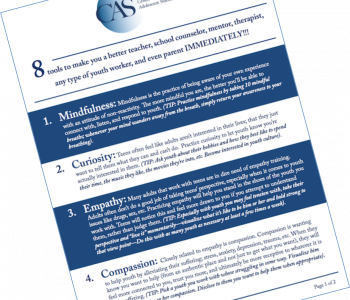

Catharine Hannay
Catharine Hannay is the founder of MindfulTeachers.org and the author of Being You: A Girl’s Guide to Mindfulness, a workbook for teen girls on mindfulness, compassion, and self-acceptance.
Three Dangerous Misunderstandings About Mindfulness
The above photo shows the type of stereotypical image that’s often used to illustrate ‘mindfulness’ or ‘meditation.’ To be fair, it can be challenging to find an image that accurately represents an abstract idea, like a state of awareness. But it’s important to do our best not to spread inaccurate depictions of mindfulness.
Three typical misunderstandings are particularly damaging:
- Dangerous Misunderstanding #1: “Mindfulness comes from Buddhism.”
- Dangerous Misunderstanding #2: “Mindfulness will make you happier.”
- Dangerous Misunderstanding #3: “Just take a deep breath.”
It may seem extreme to use the word ‘dangerous.’ There is a grain of truth in each of these statements, but they’re oversimplifications that can lead to confusion, and in some cases, real harm. The first misunderstanding causes tensions between secular teachers and people of faith, which has led to a number of lawsuits about mindfulness in public schools. The second misunderstanding can lead to disappointment and frustration, and may cause youth to give up on mindfulness before they can benefit from it. And the third misunderstanding can increase the suffering of youth who are recovering from grief or trauma.
Dangerous Misunderstanding #1: “Mindfulness comes from Buddhism.”
It’s true that some popular forms of secular meditation are adapted from Buddhist teachings. However, many Buddhists are concerned about the ways these practices have been taken out of context. Mindfulness coach Sean Fargo explains,
“Here’s the thing: mindfulness is not in and of itself ‘Buddhism’. Buddhism is based on The Four Noble Truths, of which mindfulness is a part, along with thousands of other teachings on karma, rebirth, wise intention, livelihood, concentration, etc.” (Mindfulness, Compassion, and Buddhism
Another problem with the ‘mindfulness is Buddhist’ oversimplification is that it can lead to the misunderstanding that only Buddhists practice meditation or compassion. In fact, every major religious faith already has a contemplative tradition for developing awareness and compassion, and there are many people who’ve found ways to integrate mindfulness meditation with traditional religious practices.
I’ve heard a lot of overgeneralizations about the beliefs of Christians, particularly evangelicals. Dr. Irene Kraegel teaches mindfulness at a faith-based university. She says,
“Some evangelical Christians have visceral reactions to mindfulness – it is also true that some mindfulness practitioners have visceral reactions to evangelical Christians. We are too often reacting to caricatures of one another rather than taking the time to actually know one another’s perspectives… Many Christians (including those within the evangelical tradition) are quite open to mindfulness, and even eager to integrate it into their lineup of spiritual practices.” (Can Evangelical Christians Practice Mindfulness?
And it isn’t just Christians who integrate mindfulness with faith-based practices. Imam Justin Parrott explains that mindful self-awareness can be beneficial to Muslims through “the act of inward ta’amul, to continuously examine and observe our inner life in silent seclusion.” (How to be a Mindful Muslim)
My own background is Christian, but my interest in secular mindfulness actually first came from reading books by contemporary Buddhist teachers from Jewish backgrounds, including Jack Kornfield and Surya Das. In the past couple of years, I’ve been learning about Jewish traditions with interesting connections to mindfulness. For example, Purim is an opportunity to think about the ‘masks’ we wear when we’re interacting with other people, and the gap between our masks and our authentic selves. (The Masks We Wear: Learning from Purim and Mindfulness)
The truth is, a mindful state of awareness is accessible to anyone, and every major religion has a contemplative tradition. It can be useful to think of ‘mindfulness’ as an umbrella term that covers a lot of different practices and perspectives. Or to think in terms of Buddhist mindfulness, secular mindfulness, Christian mindfulness, etc. rather than One-Mindfulness-Fits-All. This can help us present mindfulness in a way that’s respectful of others’ beliefs. Certain examples, phrasing, and types of meditation may not be appropriate for everyone, or may need to be adapted for people from different backgrounds.
If you’re interested in learning more about this, you’ll find several useful links at MindfulTeachers.org about Religious and Spiritual Perspectives on Mindfulness
Dangerous Misunderstanding #2: “Mindfulness will make you happier.”
This is probably the most common misunderstanding about mindfulness, but being ‘happier’ isn’t really the point. Not if we think of happiness in the typical way: a cheerful mood from an enjoyable experience. As Oliver Burkeman puts it, “The shortest apparent route to a positive mood is rarely a sure path to a more profound kind of happiness.” (The Antidote: Happiness for People Who Can’t Stand Positive Thinking) This reminds me of a famous quote by the French novelist Gustav Flaubert: “To be stupid, selfish, and have good health are three requirements for happiness, though if stupidity is lacking, all is lost.”
Such ‘happiness’ is the opposite of mindfulness, which can help us develop wisdom, be compassionate toward others, and face challenging circumstances with equanimity. This can ultimately lead us to a more satisfying and meaningful life, but it won’t lead to a constant state of ease and jollity. If youth expect to feel good whenever they practice mindfulness, they’ll likely be disappointed, and might give up because it’s not ‘working.’ They may even feel like they’re doing something wrong, or that there’s something wrong with them, if mindfulness brings up painful feelings.
Dangerous Misunderstanding #3: “Just take a deep breath.”
There are a few different problems with this common advice. First of all, for anyone dealing with serious issues, it can feel invalidating to hear that they ‘just’ need to do something, as if that will somehow make the situation magically get better.
A second problem with the advice to ‘take a deep breath’ is that a lot of youth misinterpret ‘deep breathing.’ Rather than a long, slow inhale and long, slow exhale, they take a big gulp of air. This can actually increase, rather than decrease, their feelings of stress and anxiety.
It’s also easy to confuse the various types of breathing exercises and breath-based meditation: Some are intended to help us focus on the present moment. Others are intended to help us relax. Both types of practices can be beneficial, but it’s important to be clear that mindful breathing is about awareness, not about inducing a particular mood. Otherwise, it can have the same unintended consequences as when youth think they ‘should’ feel happier.
The biggest misunderstanding about breath-based meditation is that it’s always beneficial. In fact, breath-based meditation, or any type of meditation, can trigger a trauma response.
In his book Trauma-Sensitive Mindfulness, Dr. David Treleaven tells the story of a young man named RJ and his teacher, Marc.
“RJ had been learning mindfulness meditation at his high school. He’d initially been open to the idea—appreciating the diversion from his usual studies—but quickly found the practice to be excruciating… He couldn’t focus on his breath and found that he left each meditation extremely agitated for the rest of the day.”
Marc realized something was wrong, and tried to skillfully respond to RJ’s distress:
- He asked to talk to RJ after class rather than putting him on the spot in front of his classmates.
- He practiced deep listening to find out what was going on. RJ confided that he was grieving for his sister, who’d recently died in an accident, and explained that he felt anxious whenever he tried to meditate.
- After hearing RJ’s story, Marc practiced skillful self-disclosure. He confided that his own sibling had died from cancer, and said that a particular type of meditation had helped him come to terms with his grief.
- He asked RJ if he’d like to try the type of meditation that he’d found helpful, and RJ agreed.
Now comes the part where Marc really messed up.
His first mistake was that he instructed RJ to close his eyes. When teaching meditation to someone who’s been impacted by trauma, it’s essential to give them the option to leave their eyes open.
RJ tried following the guided meditation, but after a few minutes he opened his eyes and said he felt scared. He’d been trying to focus on his breath but kept seeing his sister’s face.
This would have been a very good point for Marc to stop the guided meditation. Instead, he said, “It’s great that you notice that. See if you can just allow the fear to be there, without judgment.” But the more RJ focused on his grief and fear, the worse he felt, until he couldn’t stand it anymore and got up to leave the room. Until the very last moment, Marc kept telling him to hang in there and keep meditating, and it would gradually get easier.
It would have been far more helpful if Marc had stopped trying to teach him meditation until RJ was in the window of tolerance. As Dr. Sam Himelstein explains,
“The window of tolerance, also referred to by some as the therapeutic window, is that window in which a young person can engage with and be receptive to a number of different interventions that require some form of cognitive function (talk therapy, mindfulness meditation, etc.). We should use extreme caution in facilitating formal mindfulness meditations when a young person is outside the window of tolerance.” (9 Guidelines for Teaching Trauma-Informed Mindfulness to Teens)
When I participated in a training on working with refugees, our supervisor explained that if a client was triggered we should redirect his or her attention to something in the immediate physical environment. For example, “Do you see the folder on the table? The folder is red.” That type of intervention would likely have been more helpful to RJ than Marc’s repeated instructions to keep meditating.
The breath is a common ‘anchor’ or point of focus to bring the attention back to the present moment. But there are other anchors, including any of the five senses, which might be more beneficial in certain circumstances.
Conclusion
Marc wasn’t trying to cause RJ more suffering and distress. The problem was that he didn’t understand how something he found helpful personally might not be beneficial to someone else.
That’s the danger of all of these common misunderstandings about mindfulness. Well-intentioned adults can push youth away from practices that they might benefit from, or they can push youth into practices that might not be appropriate for them.
If you’d like to learn more about effective ways to teach mindfulness: Here at the Center for Adolescent Studies, you can take a free, two-hour online course on Teaching Mindfulness to Teens and/or Trauma Basics for Youth Workers
And MindfulTeachers.org has a plethora of resources on teaching mindfulness, including posts by CAS director Dr. Sam Himelstein on:
- How Mindfulness Helps Teens and the Adults Who Care About Them
- A Very Brief Introduction to How Trauma Affects the Brain and
- Eight Principles of Teaching Mindfulness Meditation to Adolescents
These resources can help you share mindfulness with your students and clients in the ways they’ll find most beneficial.

